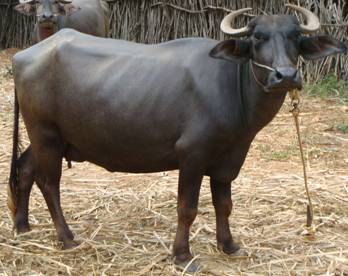|
|
|
INRODUCTION
The buffalo is a multipurpose animal. Not only is it a better source of milk than the cow, it also provides meat and works as a draught animal. Of all the domestic animals, the Asian buffalo holds the greatest promise and potential for production. It is well known that the buffalo is remarkable for its feed conversion ability. The production of buffalo milk in the Asian-Pacific region exceeds 45 million tonnes annually, of which over 30 million tonnes are produced in India alone. Buffaloes are labour intensive and cost-effective. They are the most versatile of all work animals in the variety of tasks, which they can be taught to undertake. All buffalo breeds have a strong milk/meat entity. When a buffalo is fed well and managed for early slaughter (at a live weight of 350 to 450 kg), a yield of palatable, high-grade meat can be obtained at a competitive cost.
Buffalo breeds:
1. MURRAH

Origin: The home tract of this breed is mainly in Punjab and Delhi.
Distinguishing characters:
-
The breed tract is Rohtak,Hisar and Jind of Haryana.
-
The breed characteristics are massive body, neck and head comparatively long, horns short and tightly curled, Udder well developed, hip broad and fore – and hind quarters drooping.
-
The average milk production per lactation is 1,500to 2,500 kg.
-
On an average the daily milk yield is found to be 8-10 liter, whereas a cross breed murrah buffalo gives 6-8 liter per day.
-
The age at first calving is 45 – 50 months in villages but in good herds it is 36 – 40 months.
-
The inter-calving period is 450 – 500 days
-
It performs well in coastal and slightly cold climatic areas.
SURTI
Origin: Gujarat.
Distinguishing Characters:
-
The Native tracts of this breed is Kaira and Baroda districts of Gujarat.
-
The body is well shaped and medium sized.
-
The barrel is wedge shaped.
-
The head is long with prominent eyes.
-
The horns are sickle shaped, moderately long and flat.
-
The colour is black or brown the peculiarity of breed is two white collars one round the jaw and the other at the brisket.
-
The average milk yield is around 1700kgs.
-
The age at first calving is 40 to 50 months with an intercalving period of 400 – 500 days.
-
The bullocks are good for light work.

JAFFARABADI
-
Kathiawar district of Gujarat
-
They yield appreciable quantity of milk, with an exceptionally high butter – fat content
-
The average milk yield is around 1800-2700 kg .

(Source: TNAU, Coimbatore)
Different Breeds of Buffaloes in India
| SI.No. |
Breed |
Habitat/Main State |
Breeding Tract
Districts |
Assembling Centres |
Remarks |
1 |
Jafarabadi |
Gujarat |
Kathiawar and Honreli |
Breeding areas of Saurashtra |
Dairy breed |
2 |
Murrah |
Haryana, Uttar
Pradesh, Punjab |
Rohtak, Hissar,
Karnal, Jind,
Gurgaon, Western
parts of
Uttar Pradesh
Nabha and
Patiala |
Rohtak, Bahadurgarh, Delhi, Jahanzgarh, Mahim, Hissar, Bhiwani, Hansi, Rewari, Ferozpur, Jirka, Nangloi |
Dairy Breed |
3 |
Surti |
Gujarat |
Kheda, Vadodara |
Throughout Gujarat |
Dairy breed |
(Source: NDDB)
BUFFALOE SELECTION
-
In India, we have good buffalo breeds like Murrah and Mehsana, which are suitable for commercial dairy farm.
-
Buffalo milk has more demand for making butter and butter oil (Ghee), as fat percentage in milk is higher then cow. Buffalo milk is also preferred for making tea, a welcoming drink in common Indian household.
-
Buffaloes can be maintained on more fibrous crop residues, hence scope for reducing feed cost.
-
Buffaloes largely mature late and give birth to calves at 16 to 18 months interval. Male calves fetch little value.
-
Buffaloes need cooling facility e.g. wallowing tank or showers / foggers with fan.
(Source: www.vuatkerala.org )
| |



